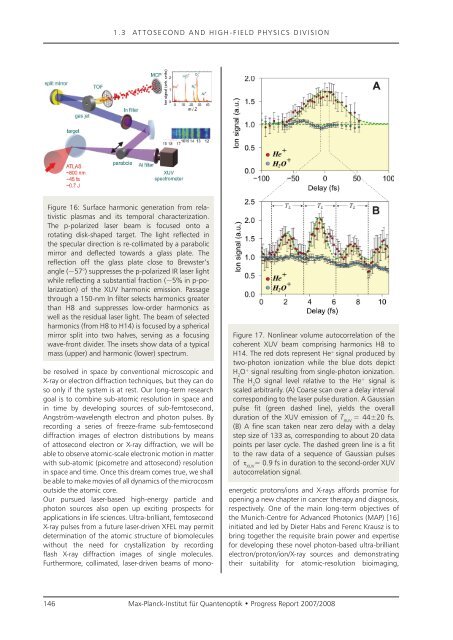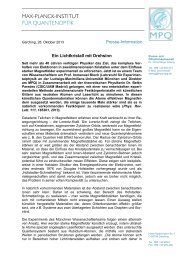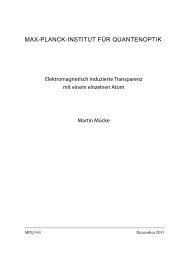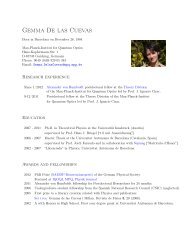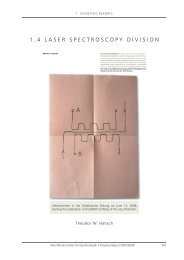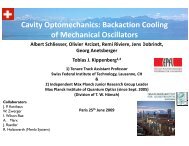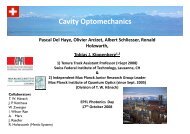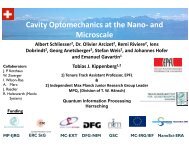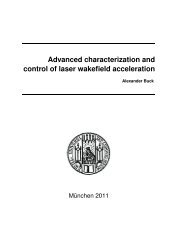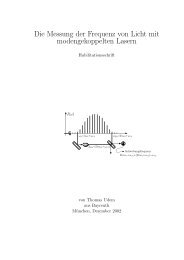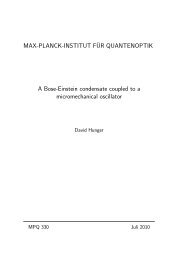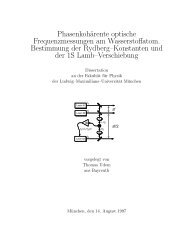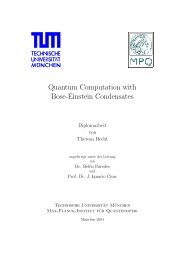Attosecond Control and Measurement: Lightwave Electronics
Attosecond Control and Measurement: Lightwave Electronics
Attosecond Control and Measurement: Lightwave Electronics
You also want an ePaper? Increase the reach of your titles
YUMPU automatically turns print PDFs into web optimized ePapers that Google loves.
1 . 3 AT T O S E C O N D A N D H I G H - F I E L D P H Y S I C S D I V I S I O N<br />
Figure 16: Surface harmonic generation from relativistic<br />
plasmas <strong>and</strong> its temporal characterization.<br />
The p-polarized laser beam is focused onto a<br />
rotating disk-shaped target. The light reflected in<br />
the specular direction is re-collimated by a parabolic<br />
mirror <strong>and</strong> deflected towards a glass plate. The<br />
reflection off the glass plate close to Brewster’s<br />
angle (~57°) suppresses the p-polarized IR laser light<br />
while reflecting a substantial fraction (~5% in p-polarization)<br />
of the XUV harmonic emission. Passage<br />
through a 150-nm In filter selects harmonics greater<br />
than H8 <strong>and</strong> suppresses low-order harmonics as<br />
well as the residual laser light. The beam of selected<br />
harmonics (from H8 to H14) is focused by a spherical<br />
mirror split into two halves, serving as a focusing<br />
wave-front divider. The insets show data of a typical<br />
mass (upper) <strong>and</strong> harmonic (lower) spectrum.<br />
be resolved in space by conventional microscopic <strong>and</strong><br />
X-ray or electron diffraction techniques, but they can do<br />
so only if the system is at rest. Our long-term research<br />
goal is to combine sub-atomic resolution in space <strong>and</strong><br />
in time by developing sources of sub-femtosecond,<br />
Angström-wavelength electron <strong>and</strong> photon pulses. By<br />
recording a series of freeze-frame sub-femtosecond<br />
diffraction images of electron distributions by means<br />
of attosecond electron or X-ray diffraction, we will be<br />
able to observe atomic-scale electronic motion in matter<br />
with sub-atomic (picometre <strong>and</strong> attosecond) resolution<br />
in space <strong>and</strong> time. Once this dream comes true, we shall<br />
be able to make movies of all dynamics of the microcosm<br />
outside the atomic core.<br />
Our pursued laser-based high-energy particle <strong>and</strong><br />
photon sources also open up exciting prospects for<br />
applications in life sciences. Ultra-brilliant, femtosecond<br />
X-ray pulses from a future laser-driven XFEL may permit<br />
determination of the atomic structure of biomolecules<br />
without the need for crystallization by recording<br />
flash X-ray diffraction images of single molecules.<br />
Furthermore, collimated, laser-driven beams of mono-<br />
Figure 17. Nonlinear volume autocorrelation of the<br />
coherent XUV beam comprising harmonics H8 to<br />
H14. The red dots represent He + signal produced by<br />
two-photon ionization while the blue dots depict<br />
H 2 O + signal resulting from single-photon ionization.<br />
The H 2 O signal level relative to the He + signal is<br />
scaled arbitrarily. (A) Coarse scan over a delay interval<br />
corresponding to the laser pulse duration. A Gaussian<br />
pulse fit (green dashed line), yields the overall<br />
duration of the XUV emission of T XUV = 44±20 fs.<br />
(B) A fine scan taken near zero delay with a delay<br />
step size of 133 as, corresponding to about 20 data<br />
points per laser cycle. The dashed green line is a fit<br />
to the raw data of a sequence of Gaussian pulses<br />
of τ XUV = 0.9 fs in duration to the second-order XUV<br />
autocorrelation signal.<br />
energetic protons/ions <strong>and</strong> X-rays affords promise for<br />
opening a new chapter in cancer therapy <strong>and</strong> diagnosis,<br />
respectively. One of the main long-term objectives of<br />
the Munich-Centre for Advanced Photonics (MAP) [16]<br />
initiated <strong>and</strong> led by Dieter Habs <strong>and</strong> Ferenc Krausz is to<br />
bring together the requisite brain power <strong>and</strong> expertise<br />
for developing these novel photon-based ultra-brilliant<br />
electron/proton/ion/X-ray sources <strong>and</strong> demonstrating<br />
their suitability for atomic-resolution bioimaging,<br />
146 Max-Planck-Institut für Quantenoptik • Progress Report 2007/2008


